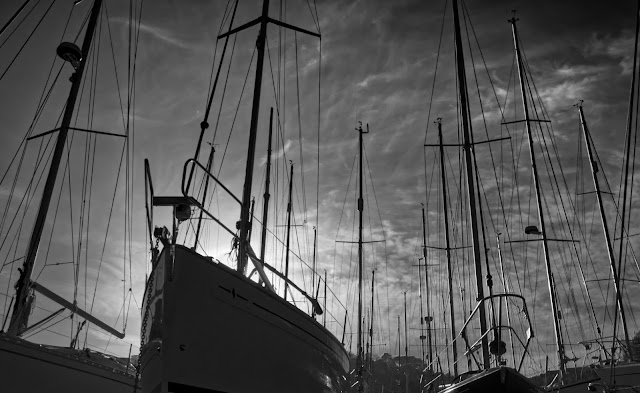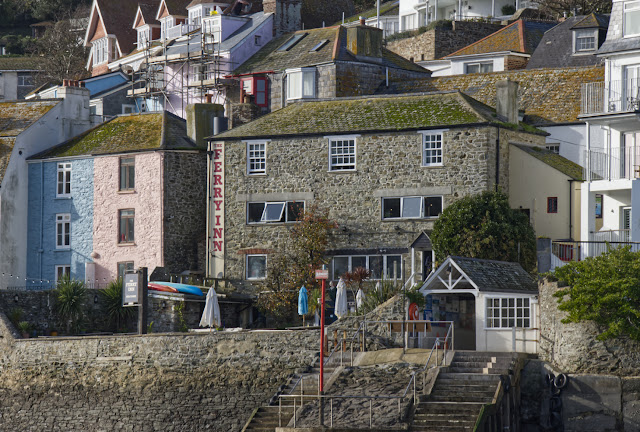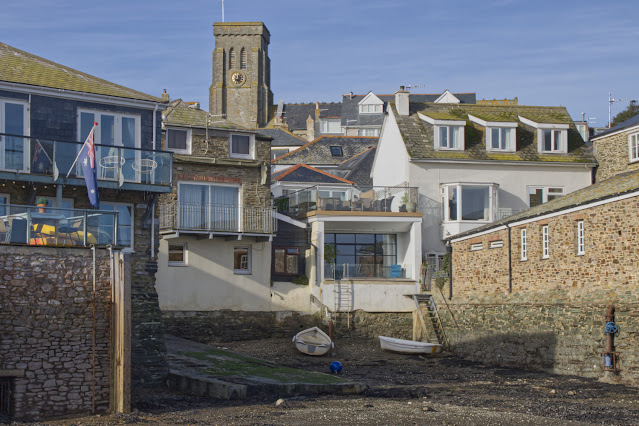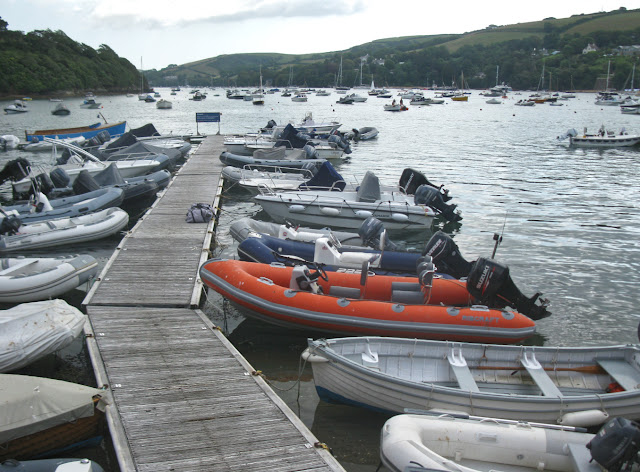Salcombe Part One
"Salcombe" first appears in the records in 1244, on the boundaries of Batson and West Portlemouth (Portlemore Barton). In 1570, there were 56 mariners while two years later another survey shows five ships under 60 tons at Salcombe.
In the 19th century, Salcombe was a major centre for shipping in the fruit trade. Salcombe vessels sailed to Iberia, the Mediterranean and the Caribbean as well as to the Azores and Newfoundland. The fruit cargoes were oranges and lemons from the Azores, and pineapples from the Bahamas and West Indies. Other cargoes brought back included sugar, rum, coconuts and shaddocks (pomelos). In addition wood such as ebony and mahogany was brought for furnishing ships.
Salcombe and Kingsbridge were busy ship-building places, producing the Salcombe schooner. This was a fast boat that could be sailed with few hands.
___________________________________________
Because we live the other side of the estuary we have a choice of driving there which is a distance of 9.1 miles or driving to the nearer East Portlemouth, 6.7 miles and catching the ferry. This also has the advantage of free parking and a ferry cost which is less than the parking in Salcombe which is also difficult to find.
The ferry runs half hourly or on demand if busy. It operates every day of the year weather permitting, by Royal Charter. The service was recently voted one of the ten best ferry rides in the UK.
“Our Royal Charter means we’re obliged to provide a service 365 days a year,” says Simon. “We only miss a day if we’ve got exceptionally bad weather and even then we try to take the workers across and back. We can cope with pretty much anything. It doesn’t bother us, as long as we can operate a safe service."
By 1871, the central part of Salcombe, excluding the outlying districts, numbered 776 people, with 34 shipwrights and 13 ships carpenters. There were also five sawyers, three block makers, two ship's riggers, three sail makers, a tin plate worker and four blacksmiths.
However, in the 1870s the fruit trade declined due to outbreaks of orange and pineapple disease and because of the advent of steamships. Some work was found taking salt to Newfoundland and returning with cod but by 1914 there were only three or four locally owned trading ships in the estuary. At this time there was the start of pleasure sailing at Salcombe with the yacht club being founded in 1874.
The Ferry Inn (circa 18th century) is an iconic pub with an unrivalled position on the waterfront, right by the Portlemouth and Kingsbridge ferries jetty. A large waterside beer garden with spectacular views, plenty of seating, all day dining and lovely drinks give a perfect location to watch the world go by.
It is a Grade 2 Listed Building.
Below is the slipway and boathouse of the old RNLI Lifeboat.
Towards the mouth of the estuary is the Bar, a spit of sand protruding from the east bank which is exposed at low spring tides. In this state of tide and with strong southerly winds the bar can make the entrance to the estuary dangerous.
It is believed that Lord Tennyson's famous poem "Crossing the Bar" was inspired by a visit to Salcombe during the 19th century. The poem begins with the lines,
Sunset and evening star and one clear call for me!
And may there be no moaning of the bar,
When I put out to sea
The moaning refers to the noise of the water breaking over The Bar.
Salcombe Lifeboat Station was established by the Royal National Lifeboat Institution in 1869. In 1916 the Salcombe lifeboat, an open rowboat "The William and Emma", capsized crossing The Bar resulting in 13 of the 15 crew's lives being lost.
However another crew was soon formed and the station continues to this day. There is a lifeboat museum and shop in Salcombe town, at the lifeboat station itself.
Although Salcombe harbour hosts a small but active shell fishing fleet of approximately 20 boats (the largest of which is less than 20m in length) the harbour is primarily a recreational leisure port which accommodates approximately 1600 residential yachts and power vessels, and which welcomes around 6,000 visiting vessels a year.
Most of this traffic is seasonal as you can see below.
By way of contrast compare that view with this one from July.
Salcombe has had a Lifeboat station for over 150 years. The current Station is operated by a team of 34 local men and women, 21 sea going, 12 shore- based and 1 Lifeboat Medical Adviser. They have 2 boats, a 25 knot Tamar Class All Weather Lifeboat ‘The Baltic Exchange III’,(seen below) and a 35 knot B Class Inshore Lifeboat ‘Gladys Hilda Mustoe’. With these boats and a volunteer crew they are able to meet their mission which is to reach any casualty, in all weathers, within 10 miles of the Station within 30 minutes of receiving an initial request from the Coastguard.
"The ALB can launch in All Weather conditions, the worst conditions we have in Salcombe are a South Easterly Gale with a Low Spring Tide, this makes crossing the Bar at the entrance to Salcombe harbour very challenging but the ALB and its crew will launch in those conditions if needed. In such conditions it would be unsafe for them to return to Salcombe in which event they may divert to Plymouth or Dartmouth to seek shelter until the conditions improved at Salcombe."
The Lifeboat was funded by The Baltic Exchange. The Baltic Exchange is a membership organisation for the maritime industry, and freight market information provider for the trading and settlement of physical and derivative contracts. It was located at 24–28 St Mary Axe, London, until the building was destroyed by a bomb in 1992.
The Baltic Exchange bombing was an attack by the Provisional IRA on the City of London, Britain's financial centre, on 10 April 1992, the day after the General Election which re-elected John Major from the Conservative Party as Prime Minister.
The one-ton bomb – concealed in a large white truck and consisting of a fertilizer device wrapped with a detonation cord made from 100 lb of semtex – was the biggest bomb detonated on mainland Britain since World War II. The bombing killed three people, injured 91 others, and severely damaged the Baltic Exchange building and its surroundings.
During the winter months as there is less boat traffic, the ferry operates from the town pontoon, instead of the usual ferry landing stage. In addition there is the Normandy Pontoon, a reminder of the large part played here in preparation for the Normandy landings of D-Day.
Because of the narrow streets and the priority given to pedestrians, a park and ride scheme operates during the summer from the outskirts of Salcombe. This service does not operate in the off-peak season but is instead signposted as 'park and walk'
Up this narrow alleyway, removed from the traffic and people, this Robin landed right next to me wondering what I was up to. He seemed very tame and curious and happy to pose. I had never seen one so close, and head on before, so I was quite surprised by the shape of his head.
I visit the church in a later post.
This was some sort of drinking trough. It may have had a water tap originally but no sign of one now. Before water was piped into homes it was supplied by freshwater springs to various points in the town.
This small unassuming shop front in Fore Street, below, has an interesting story attached. I took the photo because I liked the signage above the door. The shop today is a designer clothing brand called Jack Wills, so I was curious about what looked like the original older signage above with the same name. I have not been able to find out if the large overhead sign is indeed old and if there is any connection between the two Wills businesses, the ironmonger and the fashion boutique.
Not being a fashion victim, I knew nothing about Jack Wills so I was in for a surprise. This clothing brand was founded in 1999 by Peter Williams and Robert Shaw in this very shop. The business was started by 23 year old Williams with £40,000 . He slept in the apartment above the store.
By 2011 the company was valued at £140,000,000, with the two co-founders holding a 52% and 21% stake respectively. In 2012 Williams entered the Sunday Times Rich List, coming in at 370 with an estimated worth of £200,000,000. He stepped aside as CEO in 2013.
By 2016 there were 70 stores in the UK, Ireland, Hong Kong, Kowloon and Singapore.
After various changes of management and ownership the company collapsed into administration in 2019 with £100,000,000 of debt. Company Sports Direct bought it for £12,000,000.
Part two will continue through the centre of town on the way to the church.
































Wonderful tour and great captures Gethin - you are so lucky to have such interesting, historical places right at your doorstep. Love the framing and perspective.
ReplyDeleteThanks John. Yes we are lucky. It's much easier getting around now the holidaymakers have left.
ReplyDeleteI totally agree with John, having so many places close by with so much history. I on the other hand went and shot the Old Capitol for the 100th time today, because I could not find anything close enough to shoot (that I hadn't shot before)..
ReplyDeleteI'm shooting flower arrangements from Kroger.
ReplyDeleteAnother very interesting post Gethin. I love the idea of the "Park and Walk" not practical for everybody but a great idea for the "Able bodied". Very interesting about the Jack Wills story who would have guessed?
ReplyDelete